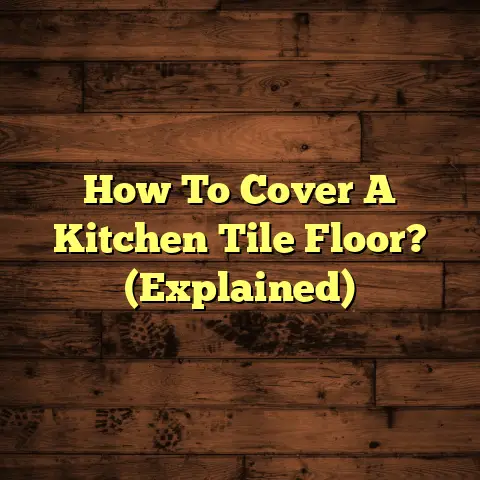Best Kitchen Waterproof Wood? (3 Top Options!)
I’m excited to dive into a topic close to my heart: wood in kitchens.
As a flooring contractor with years of experience, I’ve seen it all, from disastrous water damage to stunning, long-lasting wood installations.
Let’s get real: the kitchen is the heart of the home, but it’s also a battlefield for spills, splashes, and general moisture mayhem.
So, can wood really work in a kitchen?
Absolutely!
But, the key is choosing the right type of wood and understanding how to protect it.
A Historical Perspective on Wood in Kitchen Design
Believe it or not, wood has been a kitchen staple for centuries.
Think back to ancient civilizations, like the Romans and Egyptians.
They used wood extensively for cooking utensils, food storage containers, and even structural elements.
Wood was valued for its durability, workability, and, let’s face it, its natural beauty.
Over time, other materials like stone, metal, and eventually plastics, gained popularity in kitchen design.
But, there’s been a real resurgence of interest in wood lately, and for good reason!
It brings warmth, character, and a touch of nature into what can often be a very sterile environment.
The challenge, of course, is moisture.
That’s why waterproof wood options are so crucial for modern kitchens.
We need materials that can stand up to the rigors of daily life without warping, rotting, or becoming a breeding ground for mold.
Ready to explore some top contenders?
Let’s get started!
Section 1: Understanding Waterproof Wood
First, let’s clarify what we mean by “waterproof wood.”
Technically, no wood is 100% impervious to water forever.
But, some woods are naturally more water-resistant than others, and various treatments can significantly enhance their ability to withstand moisture.
Think of it more as “water-resistant” or “water-repellent” wood.
These treatments can include:
- Sealing: Applying a waterproof coating like polyurethane or varnish.
- Pressurizing: Forcing preservatives deep into the wood fibers.
- Oiling: Using penetrating oils to repel water and prevent drying.
Choosing the right type of wood for your kitchen is paramount.
Consider these factors:
- Durability: How well will it withstand scratches, dents, and everyday wear?
- Maintenance: How much effort will it take to keep it looking good?
- Aesthetics: Does it match your overall kitchen design and personal style?
Naturally Water-Resistant vs. Treated Woods
Some wood species, like teak, contain natural oils that make them exceptionally resistant to water damage.
Others, like pine, are more susceptible to moisture but can be made suitable for kitchens with proper treatment.
It’s a trade-off between natural beauty and the added protection of chemical treatments.
Ultimately, the best choice depends on your budget, aesthetic preferences, and how much effort you’re willing to put into maintenance.
Section 2: Top Option #1 – Teak
Alright, let’s talk about the king of waterproof woods: teak!
Teak is a tropical hardwood renowned for its exceptional durability and resistance to water, decay, and insects.
This is all thanks to its naturally high oil content.
These oils act as a built-in waterproofing agent, making teak a favorite for boat builders and outdoor furniture manufacturers for centuries.
I’ve personally seen teak decks on boats that have lasted for decades with minimal maintenance.
That’s a testament to its incredible resilience!
Visual Appeal
Teak boasts a rich, golden-brown color and a straight, even grain pattern that adds a touch of sophistication to any kitchen.
It works equally well in traditional and modern designs, adding warmth and character.
Over time, teak will naturally weather to a beautiful silver-gray patina if left untreated.
However, you can easily maintain its original color with regular oiling.
Care and Maintenance
Speaking of maintenance, teak is relatively low-maintenance.
Regular cleaning with soap and water is usually sufficient.
To preserve its color and protect it from stains, I recommend applying a teak oil or sealant every 6-12 months.
Here’s a quick table summarizing teak’s key features:
| Feature | Description |
|---|---|
| Water Resistance | Excellent due to natural oils |
| Durability | High, resistant to scratches, dents, and decay |
| Visual Appeal | Rich golden-brown color, straight grain |
| Maintenance | Low; regular cleaning and occasional oiling |
| Sustainability | Can be sustainably sourced; look for FSC certification |
| Typical Cost | High, due to its premium qualities |
Sustainability Considerations
It’s important to note that not all teak is created equal.
Look for teak that is certified by the Forest Stewardship Council (FSC) to ensure it comes from sustainably managed forests.
This helps protect against deforestation and promotes responsible forestry practices.
Section 3: Top Option #2 – Bamboo
Next up, we have bamboo, the eco-friendly champion of waterproof woods!
Bamboo isn’t technically a wood; it’s a grass.
But, don’t let that fool you.
It’s incredibly strong, durable, and surprisingly water-resistant.
Bamboo’s rapid growth rate makes it a highly sustainable alternative to traditional hardwoods.
It can be harvested in as little as 3-5 years, compared to decades for many hardwood species.
Natural Properties
Bamboo’s natural water resistance comes from its density and the presence of silica, a naturally occurring mineral that repels water.
However, like other woods, bamboo benefits from additional protection in high-moisture environments.
Finishes and Versatility
Various finishes, such as polyurethane and UV-cured acrylic, can significantly enhance bamboo’s waterproof capabilities.
These finishes create a protective barrier that prevents water from penetrating the surface.
Bamboo is incredibly versatile in kitchen designs.
It can be used for flooring, cabinetry, countertops, and even cutting boards.
It comes in a variety of colors and grain patterns, from light and airy to dark and exotic.
Environmental Benefits
Choosing bamboo is a great way to reduce your environmental impact.
It’s a renewable resource that requires minimal pesticides and fertilizers to grow.
It also absorbs more carbon dioxide from the atmosphere than many trees, helping to combat climate change.
Here’s a summary of bamboo’s key features:
| Feature | Description |
|---|---|
| Water Resistance | Good, especially with proper finishing |
| Durability | High, resistant to scratches and dents |
| Visual Appeal | Variety of colors and grain patterns |
| Maintenance | Easy to clean with soap and water |
| Sustainability | Highly sustainable and renewable resource |
| Typical Cost | Moderate, generally less expensive than teak |
A Word of Caution
While bamboo is generally water-resistant, it’s important to address spills promptly to prevent water from seeping into the seams or edges.
Also, avoid using harsh chemicals or abrasive cleaners, as they can damage the finish.
Section 4: Top Option #3 – Engineered Wood with
Waterproof Coating
Last but not least, we have engineered wood with a waterproof coating.
This is a modern solution that combines the beauty of real wood with enhanced performance and durability.
Engineered wood is made by layering multiple thin sheets of wood veneer over a core of plywood or high-density fiberboard (HDF).
This construction makes it more stable and less prone to warping or expanding than solid wood.
Construction and Moisture Resistance
The layered construction of engineered wood also makes it more resistant to moisture.
The core materials are typically treated with water-resistant resins, and the top veneer is protected with a durable waterproof coating.
Waterproof Coatings
Common waterproof coatings for engineered wood include:
- Polyurethane: A durable and versatile coating that provides excellent protection against water and scratches.
- UV-Cured Acrylic: A tough and scratch-resistant coating that is also resistant to fading.
- Ceramic-Infused Finishes: These finishes offer enhanced durability and water resistance.
Aesthetic Versatility
Engineered wood offers incredible aesthetic versatility.
It can mimic the look of virtually any wood species, from classic oak and maple to exotic walnut and cherry.
It’s also available in a wide range of colors, grain patterns, and textures.
This makes it easy to find an engineered wood product that perfectly complements your kitchen design.
Here’s a summary of engineered wood’s key features:
| Feature | Description |
|---|---|
| Water Resistance | Excellent, especially with a high-quality waterproof coating |
| Durability | Good, resistant to scratches and dents |
| Visual Appeal | Mimics the look of various wood species |
| Maintenance | Easy to clean with soap and water |
| Sustainability | Can be made with sustainably sourced materials |
| Typical Cost | Varies, depending on the species and coating |
Important Considerations
When choosing engineered wood for your kitchen, pay close attention to the quality of the core materials and the waterproof coating.
Look for products that are certified by reputable organizations, such as the National Wood Flooring Association (NWFA).
Also, be sure to follow the manufacturer’s installation instructions carefully to ensure proper sealing and prevent water damage.
Conclusion: The Future of Wood in Kitchen Design
So, there you have it: my top 3 waterproof wood options for kitchens!
From the timeless elegance of teak to the eco-friendly appeal of bamboo and the modern versatility of engineered wood, there’s a wood solution for every kitchen style and budget.
As we move forward, I believe we’ll see even more innovation in waterproof wood technology.
Manufacturers are constantly developing new coatings, treatments, and construction methods to enhance the performance and durability of wood in high-moisture environments.
Sustainability and Aesthetics
The trend towards sustainability will also continue to drive innovation in the wood industry.
We’ll see more emphasis on using sustainably sourced materials, reducing waste, and minimizing the environmental impact of wood production.
Ultimately, the key to a successful kitchen design is finding the right balance between aesthetics and practicality.
Choose materials that not only look beautiful but also stand up to the rigors of daily life.
And, don’t be afraid to experiment with different wood species, finishes, and textures to create a kitchen that is truly unique and reflects your personal style.
I hope this article has given you a better understanding of waterproof wood options for kitchens.
Remember, with careful planning and the right materials, you can create a kitchen that is both beautiful and functional for years to come!





